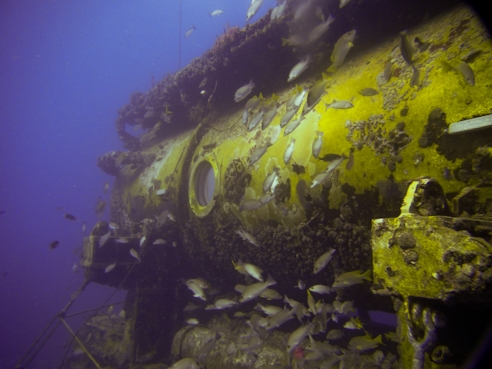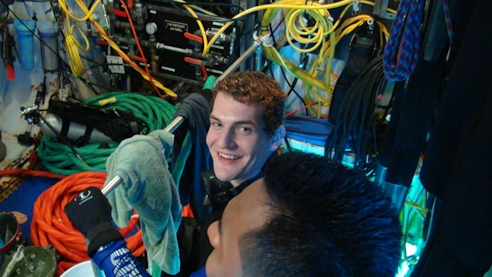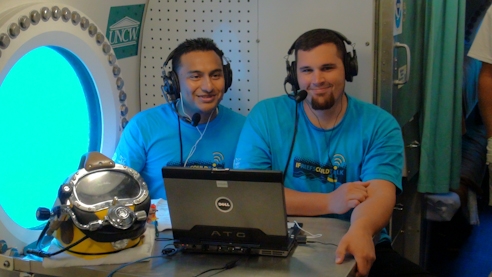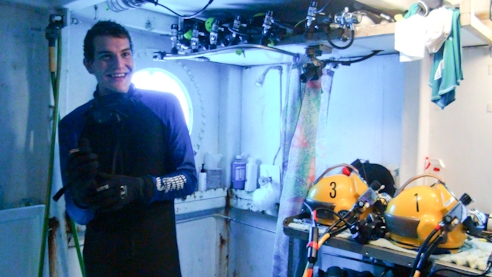When most people think of Sunny Key Largo, Florida, visions of key lime pie, and spicy conch chowder come to mind, fewer people think of the underwater habitat Aquarius. However this was precisely why I had come to visit the sunny state. The Aquarius habitat is a home to scientists as a means to conduct missions underwater in an saturation diving context. The laboratory is presently located in the Florida Keys National Marine Sanctuary (FKNMS) at a depth of 21m (63ft) but the habitat is designed to withstand pressures of up to 37m (120ft).
The side of the Aquarius habitat
I had been invited my Mitchell Tartt of NOAA’s Office of National Marine Sanctuaries to partake in a mission that was launched in October 2010 by NOAA and the University of North Carolina Wilmington’s Aquarius Reef Base (ARB). The mission was titled ‘If reefs could talk’ and it’s aim was to increase the awareness of conservation of the oceans by broadcasting a series of educational shows live from the habitat and ARB to schools all around the United States as well as live streaming via the internet.
I was extremely excited to partake in the mission because of the multi- disciplinary nature of the mission. The incorporation of both scientific research (conducted by researchers from the University of Connecticut and California State University) and educational programs to schools throughout the United States of America made it a project that encapsulated many of my interests. There was also a heavy multi-cultural emphasis throughout the mission, which I really liked. Spanish language shows were recorded everyday and sent out live just like the English versions. There was also Dr. John Parker who was a representative from the National Associated of Black Scuba divers (NABS) working with the team throughout the whole mission.
Onan one of the Spanish presenters for the show broadcasting live from the Aquarius habitat
The live broadcasting really blew me away. Every day two educational shows would go out, running live from the ‘If reefs could talk’ website. You can see it HERE and watch any of the recorded shows over the nine days that they ran. (I feature on day 9). The shows would go out to classrooms of lucky school kids who had the chance to ask questions directly to the researchers and technicians in the habitat. They were also posted live on the website for anyone to access and watch. During the broadcasts issues and topics covered included biodiversity, climate change and ocean acidification, technology testing and training, and of course what the everyday person can do to help make a difference.
During my stay with the team I had the chance to talk about the OWUSS, what the scholarship sets out to achieve and encouraged any future underwater enthusiasts to apply. I was also shown the inner workings of the Aquarius habitat, how it’s all maintained and run throughout a project such as the one that was taking place. Let me tell you, it’s a huge job! The team at ARB were a great bunch of guys and taught me a great deal. I even stayed on longer after the mission had wrapped up to spend a few days working on setting up gear for the next mission and undertaking some general maintenance at home base. I was also shown inside the life support buoy (LSB) that floats above the habitat and is the lifeline for all the people saturated down below. With no windows and filled with compressors and electronics the buoy isn’t somewhere you would want to be on rough day, fortunately when I climbed down into the central chamber the sea was like glass.
The nature of the Aquarius habitat allows for unique possibilities for research available in only a handful of places on earth. Because the scientists and technicians saturate their bodies with nitrogen they are able undertake dives that extend far beyond the recreational dive limits, in turn allowing for much more work to be completed. All these benefits are not without a risk though and the divers that saturate go through extensive training similar to that of cave diving. They have a long network of lines in which to follow to sites all around the habitat, and even more amazingly they are able to refill their tanks whilst out on missions at a number of filling stations.
Mitchell Tartt and myself
Undertaking work with all involved in the mission and seeing the unique setup of the underwater habitat was a fantastic learning experience. It exceeded my expectations and taught so much. I want to thank everyone involved that took the time to show how everything operated and welcomed me into the group, with a special thank you to Mitchell for making it all work for me.
It wouldn’t be a visit to the Florida Keys without key lime pie… 😛






